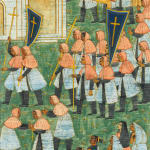Laxman Pai
Untitled (The Procession of Saint Xavier, Goa) , 1949
Signed and dated in Devanagari lower left
68.8 x 42.9 cm
27 1/8 x 16 7/8 in
27 1/8 x 16 7/8 in
Gouache and ink on paper
There are several and interesting factors about this work. Firstly it’s date, 1949, two years after the Indian Independence, during which time artists reflected the hopes and aspirations of the...
There are several and interesting factors about this work. Firstly it’s date, 1949, two years after the Indian Independence, during which time artists reflected the hopes and aspirations of the newly independent country. Painting the daily life of people on the street in India and celebrating its rich variation and history in a progressive language.
Pai uses both western and eastern techniques in this work, perhaps he was looking at Japanese woodblocks and prints as the figures are deliberately flattened and foreshortened. However, the subject is an Indian scene, specifically a Goan scene, one that millions have seen. The figures are lined up, running backwards and forwards across the sheet in a procession. They are wearing uniforms and carrying banners and flags emblazoned with Christian iconography. At the top of the composition one can see a body being carried. This is no ordinary procession but the procession of the body of the patron saint of Goa, Saint Francis Xavier.
He was a Jesuit priest and missionary who spread Christianity throughout Asia, as far as Japan. His body and relics are kept in the Basilica of Bom Jesus in Old Goa. The 3rd of December is his Saints day and every 10 years his Relics are taken out for public display in this very same procession.
This work was most likely to have been exhibited in Mumbai where Pai had several exhibitions at the Bombay Art Society before leaving for Paris. It was likely brought there with him and possibly exhibited in Paris, where he lived, alongside other young Indian artists, Souza, Padamsee and Raza. It eventually turned up in a flea market before finding its way to Sotheby’s where we acquired it. For the artistic and historical elements above it is a rare and important document of this period.
Pai uses both western and eastern techniques in this work, perhaps he was looking at Japanese woodblocks and prints as the figures are deliberately flattened and foreshortened. However, the subject is an Indian scene, specifically a Goan scene, one that millions have seen. The figures are lined up, running backwards and forwards across the sheet in a procession. They are wearing uniforms and carrying banners and flags emblazoned with Christian iconography. At the top of the composition one can see a body being carried. This is no ordinary procession but the procession of the body of the patron saint of Goa, Saint Francis Xavier.
He was a Jesuit priest and missionary who spread Christianity throughout Asia, as far as Japan. His body and relics are kept in the Basilica of Bom Jesus in Old Goa. The 3rd of December is his Saints day and every 10 years his Relics are taken out for public display in this very same procession.
This work was most likely to have been exhibited in Mumbai where Pai had several exhibitions at the Bombay Art Society before leaving for Paris. It was likely brought there with him and possibly exhibited in Paris, where he lived, alongside other young Indian artists, Souza, Padamsee and Raza. It eventually turned up in a flea market before finding its way to Sotheby’s where we acquired it. For the artistic and historical elements above it is a rare and important document of this period.
Provenance
Private collection, Paris;Grosvenor Gallery, London
Exhibitions
South Asian Modern Art 2020, Grosvenor Gallery, London, 23 July - 14 August 2020 (illustrated exh. cat. pg. 5)1
of
33










